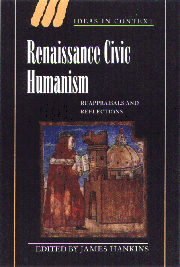Book contents
- Frontmatter
- Contents
- List of contributors
- Introduction
- 1 The republican idea
- 2 “Civic humanism” and medieval political thought
- 3 Civic humanism and Florentine politics
- 4 The two myths of civic humanism
- 5 Rhetoric, history, and ideology: the civic panegyrics of Leonardo Bruni
- 6 De-masking Renaissance republicanism
- 7 Civic humanism, realist constitutionalism, and Francesco Guicciardini's Discorso di Logrogno
- 8 Bruni and Machiavelli on civic humanism
- 9 Rhetoric, reason, and republic: republicanisms – ancient, medieval, and modern
- 10 Situating Machiavelli
- Index of manuscripts and archival documents
- General index
- Ideas in context
4 - The two myths of civic humanism
Published online by Cambridge University Press: 06 October 2009
- Frontmatter
- Contents
- List of contributors
- Introduction
- 1 The republican idea
- 2 “Civic humanism” and medieval political thought
- 3 Civic humanism and Florentine politics
- 4 The two myths of civic humanism
- 5 Rhetoric, history, and ideology: the civic panegyrics of Leonardo Bruni
- 6 De-masking Renaissance republicanism
- 7 Civic humanism, realist constitutionalism, and Francesco Guicciardini's Discorso di Logrogno
- 8 Bruni and Machiavelli on civic humanism
- 9 Rhetoric, reason, and republic: republicanisms – ancient, medieval, and modern
- 10 Situating Machiavelli
- Index of manuscripts and archival documents
- General index
- Ideas in context
Summary
In the preamble to the new statutes of the Guelf party, composed around 1420, Leonardo Bruni solemnly proclaims that liberty is a value “without which no republic can survive, and without which wise men do not think life worth living.” The statement attests to the overriding importance of the idea of liberty within the Florentine republican tradition.Cherished as the heart and nerve of the public ethos animating the political life of the Italian city-states of the fourteenth and fifteenth centuries, liberty has, during the last thirty years, probably also been the most discussed and analyzed concept in Italian Renaissance studies. Ever since the publication of Hans Baron's seminal work, The Crisis of the Early Italian Renaissance in 1955, scholarly orthodoxies have come to conceive of Florentine republicanism largely as an ideology of liberty. The political theorizing of early fifteenth-century Florentine humanists, the general argument goes, was centered around the ideal of republican liberty and the question of how it could best be promoted and preserved in the face of external aggression and threats from within. In order to relate the ideology to the historical context in which it is alleged to have developed, the image of Florence as a small and vulnerable city-state, bravely defending her liberty and free republican constitution against an outside world of powerful predatory states, has been forged.
- Type
- Chapter
- Information
- Renaissance Civic HumanismReappraisals and Reflections, pp. 105 - 142Publisher: Cambridge University PressPrint publication year: 2000
- 1
- Cited by

